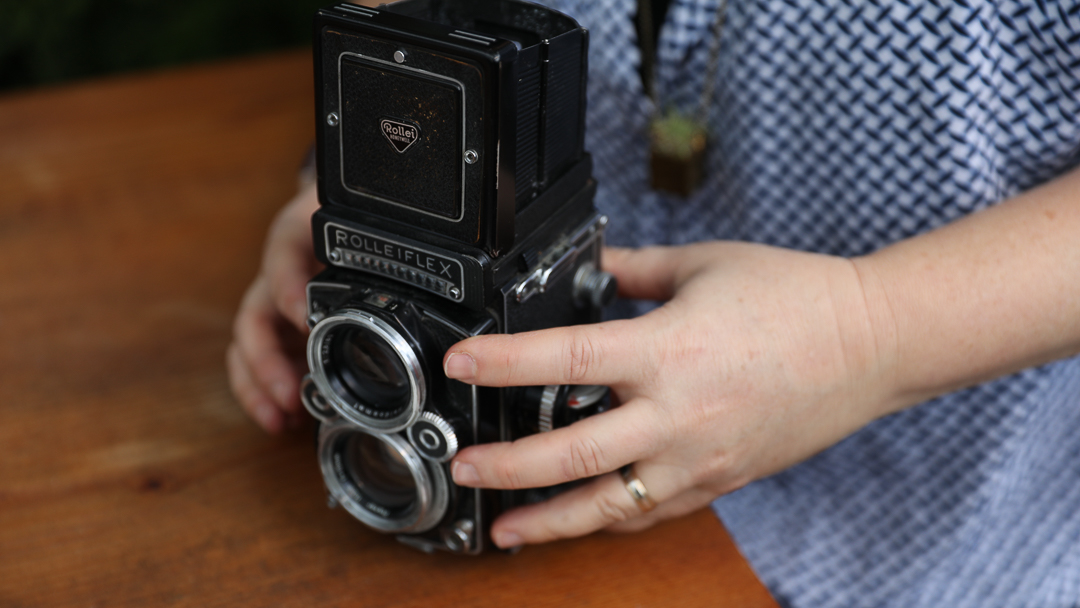Smart Plant Choice
This subtle garden is easy to drive past in a hurry, but if you stroll along the sidewalk, you’ll see drought-resistant and forgiving, low-maintenance dwarf shrubs and perennials. Shown here with a backbone of Cotinus and Juniperus chinensis ‘Torulosa’ (Hollywood Juniper), the low mounded golden Cedrus deodara, two different small-leaved Hebes, possibly H. cupressoides ‘McKean’ and H. topiaria, Santolina, and several well-behaved box (Buxus) anchor the bed.

Unique Colors
Our Seattle Grey (a future Pantone Color, perhaps?), reflected in the pea gravel, is carefully complemented with a palette of citron, lavender, and midnight purple. The Euphorbia and hellebore introduce the theme with chartreuse and pale green flowers in the spring. It is cleverly continued into summer with this dramatic combination of the golden-green Nicotiana langsdorfii, the pale lavender Catananche caerulea and the dark Alcea rosa ‘Nigra’. This blue Juniperus squamata ‘Blue Star’ echos the bluish tint of the tough Euphorbia.

You could almost miss the dark Scabiosa atropurpurea here, but it is repeated in several places and echoed with another, Scabiosa caucasica ‘Fama Blue’, on both ends of the border.

Daring Textures
This is not your grandmother’s cottage garden inviting you in for cookies and iced-tea. It is bold, dramatic and challenging. You wouldn’t want to walk your dog too close to the edge. Even the spiky Eryngium giganteum ‘Sapphire Blue’ and E. giganteum ‘Miss Wilmott’s Ghost’ say ‘go away’. Yet, these are the plants that stand up to Southern exposures and little watering. If you have sandy or well-draining soil, embrace your inner Addams Family and include these spiky, no-nonsense plants.



This garden has much to recommend it with dramatic texture, subtle color and ease of maintenance. We should all take note of the new, improved Rambler Style, get rid of our lawns, and share our gardens with our neighbors. Maybe not too closely, though.






6 Responses
Nice! I love those Eryngium. I must find a source and carry them next year. For my own house as well.
Terry
I couldn’t find any wholesale online. You might have better luck if you’re propagating them yourself. Use ripe seed as soon as possible.
So much to learn here! I make mistakes of going for the dramatic colors of annuals and end up with a bed that only looks nice for a short while. Also ends up costing more as more annuals,must be added. Also have learned from Wendy about repetition – not planting one of everything but lots of a few things. Looks so much better.
I agree. I love the chartreuse/lavender combination and want to use it in my garden. I also want to have a Hall of Shame column on this blog, but I need to start with my own garden first, before I start
pointing fingersanalyzing someone else’s garden.Love the sidewalk gardens. I have been struggling for a long time to figure out how to plant my parking strip, which is only about 2 feet wide and in the shade of a Douglas fir tree. All the ideas I’ve seen on sidewalk gardens are for sunny, or south-facing ones.
Thanks,
Sarah
Hi Sarah,
Presumably, if it is under a Doug Fir tree, the soil is thin. I would recommend adding cardboard (you always have weeds to suppress, right?) and ammending the soil with as much 3-way planting mix (the sandy stuff from Sky Nursery, or equivalent). Then plant with epimediums (dry shade), shrubby groundcovers like salal (Gaultheria shallon), wintergreen (G. procumbens) and kinnickinnick (Arctostaphylos uva-ursi) and a variety of ferns. Geranium macrorhyzum should also do well. You can also explore the Mahonias for a range of flowers from November through March, which would be good for hummingbirds, too. Good luck!